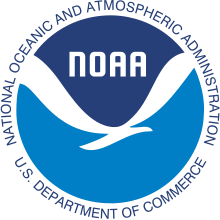NOAA Hurricane Hunters

The NOAA Hurricane Hunters work under the Aircraft Operations Center (AOC), located on MacDill Air Force Base in Tampa, Florida, United States. The Aircraft Operations Center is under the Office of Marine and Aviation Operations (OMAO), which is a branch of the National Oceanic and Atmospheric Administration (NOAA). NOAA is part of the Department of Commerce. The AOC has resided at MacDill AFB since January 1993.
NOAA announced that in 2013, Doppler weather radar data will be transmitted in real time from hurricane hunter aircraft. It should help forecasters analyze conditions faster regarding a storm. This could further improve the HWRF model forecasts by 10 to 15 percent.[1]
About
The NOAA Hurricane Hunters conduct research using special aircraft in order to support NOAA's mission of predicting changes in the Earth's environment and managing coastal and marine resources. AOC crews fly through hurricanes to help forecasters and scientists gather both operational and research data. In addition, the crews do a number of other research projects - including ocean wind studies, winter storm research, thunderstorm research, coastal erosion, and air chemistry flights to name a few.
Aircraft
NOAA uses two Lockheed WP-3D Orions and a Gulfstream IV-SP for most of its weather-related missions; however NOAA also uses light aircraft for some of its research. In conjunction with Jim Henson Productions, NOAA's P-3s are nicknamed Kermit The Frog (N42RF) and Miss Piggy (N43RF). The G-IV (N49RF) is nicknamed Gonzo.
WP-3

The WP-3s were designed to tolerate large amounts of damage since they are the aircraft that actually fly into the eye of hurricanes.[2] The WP-3 can be thought of as a flying research lab as it is equipped to take atmospheric measurements. One of the most distinct parts of the WP-3 is the giant circular black belly radar.
A normal hurricane reconnaissance or research mission can last from 9–10 hours, while a surveillance ("fix" mission) mission will typically last 8 hours, often in rotation with WC-130 flights from the Air Force Reserve Command's 53rd Weather Reconnaissance Squadron (53 WRS) at six-hour intervals. Most often, the scientists and crew aboard the aircraft deploy dropsondes with GPS which collect and transmit data as they descend toward the ocean. Once this data is received and QC'd by the crew, it is sent to the NOAA National Hurricane Center for analysis. Other data is collected and transmitted by request. Personnel on board include pilots, navigators, engineers, technicians, and flight meteorologists (Flight Directors).
Projects in the past have included a low level jet experiment over South America, a bow echo and mesoscale convective study in the Midwest, and ocean wind satellite verification missions over the Northern Atlantic and Pacific.
G-IV

The G-IV is a high altitude jet that can fly up to 45,000 feet. The G-IV has a similar crew to the P-3 with pilots, engineers, technicians, and a flight meteorologist (Flight Director)
The G-IV flies around the periphery of both tropical and winter storms, including hurricanes, and drops sondes in order to gather data about the surrounding environment. This information is used to help predict the path of hurricanes. The dropsonde message is collected and QC'd by an on-board Flight Director, who then transmits the message to the National Centers for Environmental Prediction (NCEP) and the National Hurricane Center (NHC) for analysis.
The G-IV serves the NCEP Winter Storm Reconnaissance program every year in order to better predict the location and intensity of winter storms that head for the United States. The program was started by NCEP (National Center for Environmental Prediction). During the winter storm reconnaissance, air chemistry measurements are also taken from the upper troposphere. These flights are typically flown from Honolulu, Anchorage, or Yokota AB, Japan.
See also
References
- ^ "NOAA predicts active 2013 Atlantic hurricane season". NOAA. Retrieved 23 May 2013.
- ^ Hunting Hugo - first-hand account of near-disastrous flight into the eye of Hurricane Hugo in 1989
